![]()
![]()
![]()
Use LEFT and RIGHT arrow keys to navigate between flashcards;
Use UP and DOWN arrow keys to flip the card;
H to show hint;
A reads text to speech;
33 Cards in this Set
- Front
- Back
- 3rd side (hint)
|
Paraneoplastic syndrome |
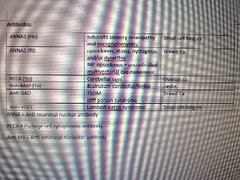
|
|
|
|
Wernicke's |
Decreased red cell transketolase MRI: enhancement of mamillary bodies due to petechial haemorrhage |
|
|
|
Restless leg syndrome |
Dopamine agonist eg pramipexole, ropinirole |
|
|
|
Essential tremor |
Propranolol Primidone |
|
|
|
Acute disseminated encephalomyelitis (ADEM) |
Post infectious encephalomyelitis IV methylprednisolone or IVIG |
|
|
|
Multiple sclerosis |
Acute relapse - steroid Disease modifying - beta-interferon, glatiramer, dimethyl fumarate, teriflunamide (inhibits NFkB and inhibits pyrimidine synthesis), alemtuzumab (CD52), natalizumab (alpha4 integrin), fingolimod (S1PR1) Fatigue - amantadine Spasticity - baclofen, gabapentin Oscillopsia - gabapentin Bladder dysfunction - anticholinergic, intermittent self-catheterisation |
|
|
|
Antiparkinsonian meds side effects |
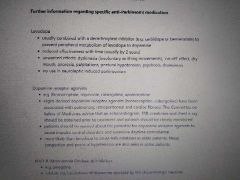
|
|
|
|
Stroke according to lobes |
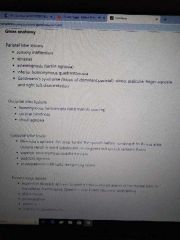
|
|
|
|
Visual field defect |
Acronym PITS Incongruous hemianopia - optic tract lesion Congruous hemianopia - optic radiation Congruous hemianopia (macula sparing) - visual cortex |
|
|
|
Phenytoin side effects |
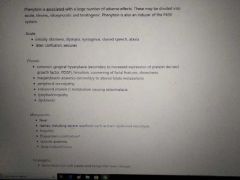
|
|
|
|
Macroglossia - causes |
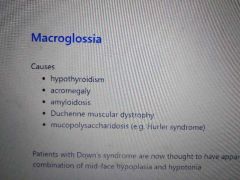
|
|
|
|
Valproate side effects |
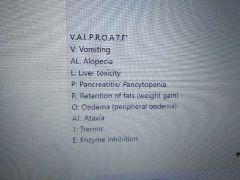
|
|
|
|
Peripheral neuropathy |

|
|
|
|
Friedrich's ataxia mnemonic |
Frataxin (chromosome 9) Recessive I Eye - optic atrophy, retinal degeneration Diabetes Repeat GAA disorder but no anticipation E I Cerebellar involvement High-arched palate + HCOM Scoliosis |
|
|
|
Stroke by anatomy |
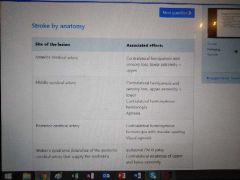
|
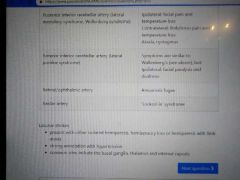
|
|
|
Trinucleotide repeats |
CAG - Huntingtons disease GAA - Friedreich's ataxia CTG - Myotonic dystrophy CGG - Fragile X syndrome |
|
|
|
Vestibular schwannoma |
CNV, VII, VIII Mostly unilateral Bilateral is seen in NF2 (chromosome 22) |
|
|
|
Pituitary apoplexy |
Can mimic SAH Hypopituitarism - adrenal insufficiency, hypothyroidism |
|
|
|
MS investigations |

|
|
|
|
Gingival hyperplasia |
Phenytoin Ciclosporin CCB AML |
|
|
|
Hypertrophic Olivary degeneration |
Palatal myoclonus Triangle of Guillain and Mollaret |
|
|
|
Cluster headache treatment |
Subcut sumatriptan 100% oxygen |
|
|
|
3rd nerve palsy + headache |
Posterior communicating artery aneurysm |
|
|
|
Parinaud syndrome |
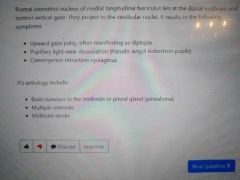
|
|
|
|
sporadic vs variant CJD |
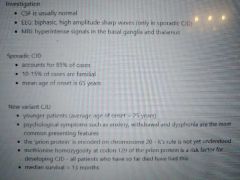
Pulvinar sign on MRI in vCJD |
|
|
|
Intracranial haemorrhage CT head |
Hyperdense (bright) = acute Hypodense (dark) = chronic Extradural: limited by suture line Subdural: crescent around the convexity, not limited by suture line SAH: basal cistern, sulci |
|
|
|
Chorea |
Caudate nucleus in basal ganglia Learn the causes: Huntington, Wilson, ataxic telangiectasia, SLE, APLS, rheumatic fever (Sydenham chorea) , OCP, levodopa, antipsychotics, pregnancy (chorea gravidarum) , carbon monoxide, thyrotoxicosis, PCV |
|
|
|
Nystagmus |
Upbeat = cerebellar vermis lesion Downbeat = foramen magnum lesion eg Arnold chiari malformation |
|
|
|
Causes of Parkinsonism |
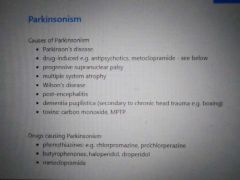
|
|
|
|
Myotonic dystrophy |
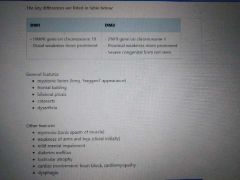
|
|
|
|
Basal ganglia 4 parts |
Striatum - dorsal striatum: caudate nucleus (chorea) and putamen - ventral striatum Pallidum: globus pallidus + ventral pallidum Substantia nigra Subthalamic nucleus (hemiballism) |
|
|
|
Memantine for moderate Alzheimers |
MMSE 21-26 mild 10-20 moderate <10 severe |
|
|
|
Dementia |
Alzheimer's - amyloid plaques, NFT, ApoE4 variant, donepezil, memantine Vascular Lewy body - alpha synuclein deposit, SPECT, treat with rivastigmine, AVOID antipsychotic Frontotemporal - SSRI eg paroxetine |
|

